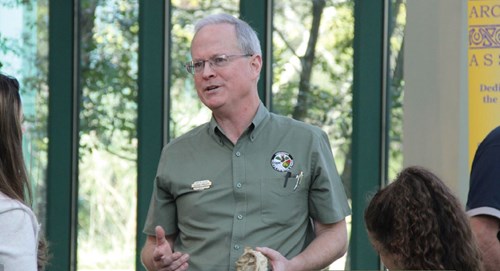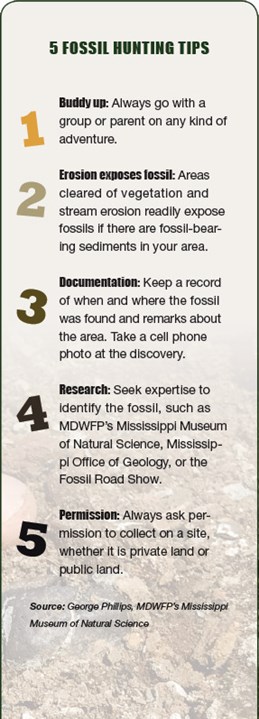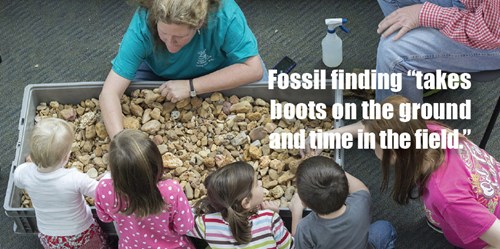Road Trip to the Past
2/26/2018 10:18:35 AM
By Sherry Lucas

Paleontologist George Phillips picks his way carefully along the edge of Luxapallila Creek in Columbus as an advanced rock hound trails behind. As he glances back, his eyes sweep the ground and snag on something.
“You walked right past it,” he says.
There it is, right on top of the ground. No digging, poking, clod busting, or sifting required. Just a keen and knowing eye to spot a fossil shark tooth, dirty but white in the midday sun, among the clay, dirt, and rocks.
Other finds would take at least a scratch of the surface that day, but each prompts a story: the type of shark, identifying amber, fun with coprolites (kids give the best reactions to fossilized poop).

MDWFP Paleontologist George Phillips
At the 15th annual Fossil Road Show, to be held on March 3, that fun comes in from the field, as the public packs up their fossil finds and brings them by the Mississippi Department of Wildlife, Fisheries, and Parks’ Mississippi Museum of Natural Science, for expert opinions on age and identity.
The museum’s third most popular annual event (on par with Snake Day) draws in 600 to 900 enthusiasts in search of answers from Phillips and a cadre of regular and visiting experts that include geologists, archaeologists, and paleontologist.
The event’s size works well, museum director Charles Knight says. “We want the people who come here to be able to talk to our experts.”
Amateur collectors love the opportunity to show off their discoveries and engage the public. Gem and mineral societies set up displays to attract fans and educate. Kids get a chance to dig around in gravel for fossils. Another activity, led by artists for kids and adults, uses fossils as an introduction to scientific illustration.
“It’s the most inter-generational event we do,” with grandparents and grand-children bringing in their finds, museum event planner Nicole Smith says. “They’re passing their love of fossils onto the next generation. I love that.”

One year, the show featured a display by Phillips that showcased all the fossils collector Jeff McCraw of Bay Springs had donated to the museum.
“It’s this kind of collector who makes a collection possible—these collectors who are generous enough to donate the more scientifically important items to an accredited research institution like the MDWFP’s Mississippi Museum of Natural Science,” Phillips says.
A museum’s most important specimens, outside of those on display, are voucher specimens that are proof of something that once existed in a particular area and time in the past. Scientists do not report or publish on a new species or an existing species in a new location until a voucher specimen exists in an accredited research institution, he says.
The Fossil Road Show is an educational outreach to the community that also provides a look at what people are finding. “We want to get some kind of cross-section of what people are discovering out there,” Phillips says. Though they often hope to turn up key specimens that will be donated and add to Mississippi’s official fossil record, that is not the event’s primary aim.
The idea for the Fossil Road Show originated with museum volunteer and senior docent John Davis, who saw a connection between his own family history and a popular television show.
“The title, of course, was cribbed from the beloved PBS program, ‘Antiques Roadshow,’” Davis says. A previous director of education, Martha Cooper, implemented the idea in 2002.
“Fossils, like antique objects, are durable. People get a great deal of pleasure out of collecting them, but sometimes, like the antiques of ‘Antiques Roadshow,’ they become legends in their family, passed down from generation to generation,” Davis says. His own family’s fossil, known as Great Grandpa’s Lion Claw, fascinated him as a child.
“Of course, nothing could be classier than a lion claw. In point of fact, it turned out to be something much more interesting,” Davis says, who was delighted when he found out the truth. “It was the claw of an astonishing, enormous, forbivorous beast known as Jefferson’s ground sloth.”
Intriguing fossils and unusual finds often are not fully understood until identification from an expert.
Paleontology, like astronomy, is an area where amateurs still make major contributions, Davis points out. Amateur fossil hunters should always have permission to be on hunting grounds and keep a record of things they pick up. “When fossils are looked at scientifically,” Davis says, “context is everything.”
The Fossil Road Show was a hit from the start.
“There’s nothing like the excitement of children, bringing in the fossils found in the schoolyard gravels,” he says (those found in chert gravels, the kind that winds up on playgrounds, are the oldest found in the state). “The children would be astounded to know what they picked up … as excited as any young hunters can be.”
Avid artifact hunter Eddie Mooney is often on the lookout for arrowheads when he peruses the creek on his hunting camp property in Jefferson County. He had found a few bones here and there, including a claw core and a tooth from a Jefferson’s ground sloth.
“I sent the pictures to George (Phillips),” says Mooney, “and he was happy as a lark with all that.”
“The next weekend, I found a pretty good-sized rib bone. I’m not sure what it came out of, but it was Ice Age.”
He stepped around what he thought was a log or a root, then turned around for a closer look. It was big. “I realized it was a bone … and I was just ecstatic! I didn’t hunt anymore that day, let’s put it that way.” The strapping, two-foot relic was the upper arm bone, the humerus, of a Harlan’s ground sloth — the most intact one found in Mississippi and Alabama. Mooney donated it to the Museum of Natural Science.

Fossil finding “takes boots on the ground and time in the field,” Mooney says. He is out there every chance he gets, “once all the deer hunters are out of the woods.”
That year at the Fossil Road Show, it was not the only bone from a Harlan’s ground sloth, “a rare giant sloth species we don’t encounter very much,” Phillips says.
Alli Ammons of Bentonia, also brought in one. After a rain, she and her dad, John Ammons, walked the creek that runs through their family land.
“We both saw it at the same time … We thought it was, like, a cow or something,” says Alli Ammons, 12. It was dirty, with rocks inside and five or six teeth attached. “We washed it off with the water hose.”
At the Fossil Road Show, she found out it was the jawbone of a Harlan’s ground sloth. It created a buzz.
“I felt like a celebrity because everybody was wanting to take my picture,” she says, recalling the thrill. She, too, donated the bone to the museum.
Alli continues to fossil hunt, with a lot of horse teeth, a mastodon tooth “and a whole five-gallon bucket of petrified wood” among her finds. The creek she walks with her family is a fertile spot not just for discovery, but also for imagination.
“It’s so fun because I like to think of Indians and old animals and stuff walking where I was walking, and I like to play like they’re going to hunt me down or something.”
Sherry Lucas is a freelance writer for Mississippi Outdoors.



